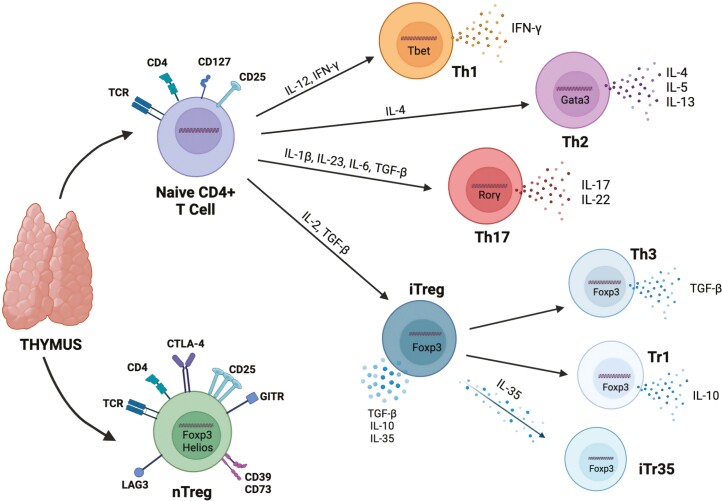Figure 1:
CD4+ T helper cell differentiation. Naïve CD4+ T helper (Th) cells and naïve Regulatory T cells (nTreg) are generated in the thymus after undergoing positive and negative selection against self-antigen. nTreg are naturally derived and express high levels of FoxP3 and Helios transcription factors, along with the T cell receptor (TCR or CD3), CD4, low levels of CD127, and high levels of CD25 (IL-2Rα), CTLA-4, GITR, CD39, CD73, and LAG3 to maintain their natural suppressive function. Other naïve CD4+ T helper cells leave the thymus where they differentiate into Th1, Th2, Th17, or induced Treg (iTreg) based on polarizing cytokines and transcription factor expression. Th1 cells are polarized in the presence of IL-12, IFN-γ, and Tbet. They primarily produce IFN-γ and are considered to be pro-inflammatory effector populations. Th2 cells are polarized by IL-4 and generally express Gata3 and produce IL-4, IL-5, and IL-12 to mediate allergy and humoral responses. Proinflammatory Th17 cells are generated in the presence of IL-1β, IL-23, IL-6, and TGF-β. They are defined by RORγt expression and production of IL-17 and IL-22. In addition, immunosuppressive Tregs can be induced in the periphery from Foxp3-Th cells (iTreg) when IL-2 and TGF-β are present. These cells will begin to express the same immunosuppressive markers as nTreg, as well as stable expression of the FoxP3 transcription factor. They produce anti-inflammatory cytokines, TGF-β, IL-10, and IL-35. iTreg can be further broken down into TGF-β-producing Th3, IL-10-producing Tr1, and IL-35-producing iTr35 depending on their predominant cytokine production.

